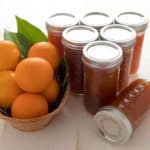Seville Orange Marmalade
Seville Orange Marmalade is prized in Great Britain. Legend has it that this perfect marriage of the intensely bitter Seville oranges and the sweetness of sugar occurred by accident in the early 1700’s in Scotland.
Servings: 108 servings
Calories: 62kcal
Ingredients
- 6 pounds Seville Oranges
- 2 lemons
- 6 cups water
- 7 cups granulated sugar, or more to taste
Instructions
- Wash the oranges and lemons well. Cut the oranges and lemons in half. Squeeze the juice from the oranges and lemons using a citrus juicer. Add the juice and the water to a large Dutch oven. Place the pips or seeds and any bits of pith that cling to the juicer on a piece of cheesecloth laid over a small bowl.
- Cut the orange peel and the lemon peel into quarters with a sharp knife. Place the orange peel and lemon peel in the bowl of a food processor fitted with a steel cutting blade. Process until coarse. Add to the Dutch oven. The pith contains a lot of pectin so don't discard any, and don't worry about any pith and skin that clings to the shreds - it all gets dissolved in the boiling.
- Tie the cheesecloth loosely to form a little bag, and tie this onto the handle of the pan so that the bag is suspended in the liquid. Bring the liquid up to a simmering point, and simmer gently, uncovered, for two hours, or until the peel is completely soft - test a piece carefully by pressing it between your finger and thumb.
- Remove the bag of seeds and pith and leave it to cool in a saucer.
- Add the sugar into the Dutch oven and stir over low heat until all the crystals have dissolved (check carefully, it's important). Taste for the desired level of sweetness. Increase the heat to high.
- Squeeze the bag of seeds into the Dutch oven to extract all of the sticky, jelly-like substance that contains the pectin. As you squeeze, you'll see it ooze out. You can do this by placing the bag between two saucers or using your hands. Then stir or whisk it into the rest of the mixture.
- Place several small saucers into the freezer to later use to test the doneness.
- As soon as the mixture reaches a really fast boil, start timing. Then after 15 minutes, spoon a little of the marmalade onto one of the cold saucers from the freezer, and let it cool back in the freezer. When it has cooled, you can tell if you have a "set" by pushing the mixture with your little finger; if it has a really wrinkled skin, it is set. If not, continue to boil the marmalade and give it the same test at about 10-minute intervals until it does set. (This generally takes 45 to 55 minutes for the marmalade to set.)
- After the marmalade has set, remove the Dutch oven from the heat. Spoon any scum from the top.
- Leave the marmalade to settle for about 10 minutes.
- In the meantime, the jars (washed, rinsed, and dried first) should be heated in a 200º F oven for about 10 minutes. The tops should be boiled in water for about 5 minutes.
- Pour the marmalade, with the aid of a funnel, into the jars, and seal them while still hot. If the jars do not seal themselves, place them submerged, in boiling water for 10 minutes. Remove and wait to hear the "pop" indicating that the jar has been sealed. Yield: nine 12-ounce jars of marmalade.
Nutrition
Calories: 62kcal | Carbohydrates: 16g | Potassium: 48mg | Sugar: 15g | Vitamin A: 55IU | Vitamin C: 14.4mg | Calcium: 11mg
